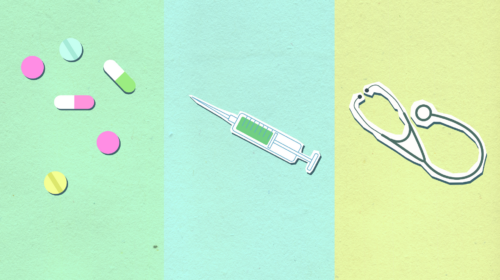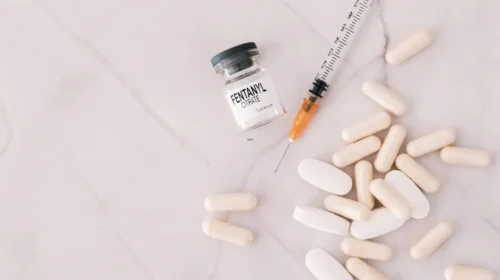It makes intuitive sense that survivors of trauma are more at risk for addiction. Treatment, theory, and research support the ways traumatic events become an organizing force shaping how individuals seek physical and emotional safety in efforts to eliminate emotional pain. Survivors may use substances in an effort to manage emotional distress. What may start out “adaptive” in terms of short-term powerful relief, rapidly becomes “maladaptive” as substances bring with them their own destruction of the body’s natural coping resources in lasting ways. Temporary relief with mind-altering substances leaves behind profound and lasting damage to the brain’s activity and the mind’s expectations for what will restore balance.
In treatment, it is helpful to think of trauma and addiction as “co-occurring disorders” as both disorders have their own symptoms and neurobiological changes, but also overlap and interact with each other. Not only is it difficult to treat them separately, but there are other factors that interact with each. Other mental health issues, medical problems, and biopsychosocial factors such as gender, ethnicity, and socioeconomic status contribute their own influence on health-related risks. For recovery to succeed, a trauma-informed model of treatment is needed to address the physical, psychological, social, and neurobiological issues that underlie addiction. Trauma-informed services take traumatic events into account to help survivors manage their trauma symptoms successfully and avoid re-triggering and re-traumatizing without the use of substances to achieve these goals.
Defining the Human Mechanisms of Trauma
Trauma can be defined as experiencing, witnessing, or being threatened with an overwhelming event or a series of events that involve intense feelings of fear, helplessness, actual serious injury, a threat to the physical integrity of one’s self or others, or potential death. The individual’s response to these events includes intense fear, helplessness, or horror and can have long-lasting adverse effects on an individual’s functioning and mental, physical, social, emotional, or spiritual well-being.
Examples of trauma can be highly individualized, as what is traumatic to one person may not always be traumatic to another. An individual may experience a traumatic event and corresponding stress response without developing post-traumatic stress disorder (PTSD). Our bodies may involuntarily experience a reaction to an event but return to a regulated and balanced state. For example, experiencing a car accident can create terror and helplessness at the moment, but the aftermath may include a return to safety or healing, and the body and brain recover in an integrated way.
Traumatic events that often correspond with PTSD include recurrent and severe emotional or physical abuse as a child, sexual abuse, physical and emotional neglect, imprisonment, mental illness, witnessing domestic violence, or the absence of parents. Events such as natural disasters, violent crime, poverty, racism, and inter-generational cultural trauma can provide additional layers of traumatic events that become deeply ingrained influences on the way we interact with our world. Many of these events do not have a clear starting and ending point, so the opportunities for stabilization are decreased.
Prolonged stress of a social and/or interpersonal nature, especially in the context of interpersonal dependence (i.e., parent-child) has a greater impact on the brain’s efforts to adapt and regain balance. When recurring traumatic events take place for a child who is still developing the internalized skills and resources to cope with stress, the impact is more detrimental and lasting. The growth of the brain is affected by one’s experiences, both the positive and the negative. Some positive experiences lead to the brain developing in ways that are beneficial, but experiences can also be negative and disrupt the brain’s development. In these situations, the individual may expect that safety will never arrive.
Self-Medication of Post-Traumatic Stress Disorder Symptoms
Some theories suggest that the reason for the association between trauma and addiction is self-medication to alleviate PTSD symptoms. The origins and effects of how one condition informs the other vary from case to case, but there is supportive data to suggest that post-traumatic symptoms often precede the development of substance use problems, which supports the idea of self-medication. There is also evidence to support that the choice of drug is linked with the type of post-traumatic symptoms being experienced. Alcohol dependence can be more strongly associated with hyperarousal symptoms than cocaine dependence. An individual’s drug of choice, either depressant or stimulant, may reflect an attempt to alleviate a particular type of symptom.
For many, substance abuse may temporarily offer relief from PTSD symptoms. People with insomnia and hyperarousal may use alcohol to excess to black out and sleep, although the sleep quality is disrupted. Stimulants may create excitement to override feeling numb. Opioids can reduce anxiety. If substances didn’t provide some form of temporary relief, fewer people with PTSD would develop SUD. Considering addiction as self-medication of trauma also makes sense as a framework for helping individuals develop recovery plans and engage in treatment as a means to find self-compassion and change.
Why People with PTSD use Substances:
- To numb their painful feelings (self-medication).
- To try to relax.
- To forget the past.
- To go to sleep.
- To prevent nightmares.
- To cope with physical pain.
- To stop dissociation and flashbacks.
- To feel some pleasure in life.
- To let out their anger.
- Peer pressure.
- To socialize with other people and feel accepted.
- Family members drank or used drugs when they were growing up.
- It was common in the military.
- To get through the day.
- To show people how bad they feel.
- To commit “slow suicide.”
Examining the Relationship between Trauma and Addiction
Given the overlapping neurological systems engaged in processing traumatic events and the use of mind-altering substances, substance use disorders and post-traumatic stress disorder co-occur at a high rate. Individuals with PTSD are two to four times more likely than individuals without PTSD to also meet the criteria for SUDs. In Veteran populations, almost half (41.4%) with an SUD were also dually diagnosed with PTSD. As many as 59% of young people with PTSD go on to develop SUDs. The presence of either disorder increases the risk for the development of the other, and the combination results in poorer treatment outcomes. A recent study assessed army Veterans post-deployment from Iraq and found a significant association between the severity of combat exposure and alcohol misuse. Those with a higher severity of combat exposure had 93% higher odds of screening positive for alcohol misuse.
Addiction also exacerbates trauma symptoms, including sleep disturbance, nightmares, rage, depression, avoidance, numbing of feelings, social isolation, irritability, hypervigilance, paranoia, and suicidal ideation. Substance use disorders are two to four times more prevalent in people with PTSD than those without PTSD. Among people with PTSD, 52% of men and 28% of women develop an alcohol use disorder. PTSD increases the risk of alcohol relapse.
Medical Model and Behavioral Sciences
The medical model of addiction is critical to understanding recovery. This model shows that addiction is similar to medical chronic disease in that it is a chemical/biological issue that is a primary, progressive disease that is chronic and, ultimately if left untreated, fatal. Substance use disorders are associated with brain changes in the reward pathways, and recovery improves brain functions. Addiction treatment medications can ease physical discomfort in the discontinuation of substance use and support long-term recovery activities as they relieve withdrawal and craving.
Addiction treatment medications are most effectively used in partnership with behavioral science in the treatment of addiction and integrate the ways traumatic experiences may lead to the use of substances. Recovery planning needs to bridge the history of the potential causes for substance use by treating the physical impairment of substance use and designing successful changes in coping skills and self-regulation skills to protect against relapse. If addiction is a chronic relapsing disease, integrating trauma-informed care into recovery planning targets the core risks for triggers for relapse. It may not be so coincidental that we refer to “triggers” when describing PTSD and SUD treatment plans separately.
Mechanism vs. Cause of Associated Trauma and Addiction
The relationship between childhood trauma and addiction has been well-researched. Disruptions in adaptive functioning capacities caused by trauma stress can be explained by a significant study by Vincent Felitti MD and Kaiser Permanente with the Adverse Childhood Experiences study (ACE). This study was conducted with 17,421 Kaiser Permanente patients, linking many different stress-inducing experiences (like child abuse) during childhood to substance use and impulse control disorders later in life. This study expanded the association of child abuse as a key stressor and included other stress-inducing and traumatic experiences that were shown to increase vulnerabilities for addiction. Additional stressors included neglect, the loss of a parent, witnessing domestic or other physical violence, and having a family member who suffers from a mental illness. Experiencing these events during childhood was shown to increase the risk of becoming dependent on alcohol and drugs. Behavioral addictions were also a higher risk outcome, such as compulsive eating and compulsive sexual behavior. it’s also common for substance use behavior in adulthood to be modeled after a loved one’s substance use behavior that had been witnessed during childhood. The tendency to self-medicate can be learned as we grow up and pass on to the next generation.
Adverse Childhood Experiences and Adult Substance Use
Adults with a high number of adverse childhood experiences (ACEs) were more likely than their peers to report early drug use in their lifetime. The higher the number of adverse experiences, the greater the likelihood of starting drug use. This relationship is likely an effort to cope with experiences that overwhelm the system. When early childhood traumatic experiences occur, there are fewer available resources developmentally to draw on to re-regulate emotions and trust in one’s ability to maintain safety. This relationship held true after adjustment of data for gender, baseline age, race, and educational attainment.
Disconnection and Healing after Trauma
Experiencing a traumatic event causes the human brain to react automatically into a fight, flight, or freeze mode in order to ensure survival. The well-known term “fight-or-flight” represents the choices our more primitive ancestors had when faced with danger in their environment; we could either fight or flee. Either way, the physiological and psychological response to stress prepares the body to react to the danger. This response triggers the release of hormones that prepare our body to either stay and deal with a threat, or to run away to safety.
If fight or flight fails, the brain can move into a “freeze” response to numb our emotions so that we can disconnect from the overwhelming experience. Biologically speaking, the body prepares for an inevitable injury or death by seeking to decrease pain or realization of what is happening to our bodies. To seek safety from intense threats in our physical reality (such as physical abuse or sexual assault), we may dissociate, and disconnect our minds from our reality. We may retreat into isolation, depression, and detachment. If we survive, this freeze response, although temporarily effective in reducing distress, also disrupts the brain’s information processing.
Post-traumatic stress disorder is when the body continues to experience the automatic reactions of the body and the memories that may be associated with the painful event. The body feels as if it is reliving the event. The messaging systems in the body that can bring us back to feeling safe after the event are disrupted and not communicating. Sleep, appetite, and digestion are disrupted, and neurotransmitters are out of balance, leading to low motivation, avoidance, and hyperarousal. We feel frozen in time and repeat the experience over and over. In freeze mode, individuals may become self-destructive in deliberate efforts to regain control when emotions are out of control. We may become destructive when consumed with pain and fear and act out the inner feelings of a painful emotional state.
The connection and disconnection of the mind and body are a central theme for trauma survivors. Survivors seek to balance the overwhelming negative feelings, memories, and hyperarousal from an internal system of being in a world that feels disrupted. Recovery is the process of re-learning how to manage symptoms without substance use, reconnecting with safety to ourselves and others, developing trust in ourselves and others, and regaining the control that was lost. Successful recovery environments include treating the biological, psychological, and social parts of ourselves and restoring connection.
Recurrent traumatic events can also help to explain how our negative beliefs about our self-worth and our expectations for change can be emotionally ingrained into our minds and bodies. Imagine an adult who comes to therapy believing they have no self-worth and believes no matter what they do, they will fail, and their alcoholism developed as a nightly ritual to cope with the daily belief that they are a failure despite achievements of loving relationships and work achievement. A therapeutic discovery comes when the links are made that as a child, they felt rejection and chronic verbal abuse at any effort to connect emotionally with a parent.
The inner narrative that they are “not good enough” has become an expectation that is so deeply learned it is hard to be unlearned with clear evidence to the contrary. The expectation of failure is deep. The internalized memory is that achievements are probably luck, will all disappear, or that perfection is needed to maintain them. Our memory circuits can be rewritten by traumatic events, and repeated traumatic events further deepen the struggle to expect a different outcome. “I will never be good enough.” When the memories and the feelings can be reconsolidated in a way that acknowledges the individual’s achievements and strengths despite early experiences, we can learn new ways to feel confidence and self-esteem and change the narrative from “what is wrong with me” to “what happened to me.”
Research on integrated and simultaneous treatment of trauma and addiction suggests:
- If PTSD symptoms decline, so do SUD symptoms
- If SUD symptoms decline, PTSD symptoms do not.
- Therefore, treating substance abuse without treating PTSD will fail
Treating one disorder without treating the other is ineffective:
- Sequential treatment (usually SUD first) is ineffective.
- Fully integrated treatment is optimal.
- Simultaneous treatment is next best.
The Need for Trauma-Informed Treatment
Trauma-informed care refers to organizational culture and practice. Trauma-informed care is an approach in the human service field that assumes that an individual is more likely than not to have a history of trauma. Similar to “universal precautions” such as hand-washing before a patient interaction, being trauma-informed is a universal precaution that should be used with all individuals, whether they self-report trauma or not, when seeking substance use treatment. Based on overwhelming prevalence, trauma-informed services are ones that ask all consumers about trauma, as part of the initial intake or assessment process. This communicates to all consumers that the program believes abuse and violence are significant and real-life events, and that staff are open to hearing about and discussing painful events. This helps to develop collaborative relationships with trauma survivors and offer services that best match their needs.
The trauma-informed dictum is “above all, do no harm.” Providers understand that survivors may fear self-disclosure. Providers recognize that some survivors have personal boundary challenges that impair self-protection and the intensity of their trauma experience. Helping trauma survivors contain and cope with intense feelings using grounding and centering techniques is a primary step in treatment. This allows survivors to establish trust and safety, and to engage in treatment without a fight or flight response. For some, exploring traumatic memories can even be damaging without safety and resources to contain emotions. Childhood sexual abuse is the single strongest predictor of suicidality regardless of other factors.
Helping individuals focus on self-regulation skills first is important. A safe exploration of trauma will unfold over time. For some survivors, their experiences of powerlessness and lack of choice have been pervasive, such that having control over the pace and content of trauma is critical. People with both PTSD and SUD have significantly worse outcomes when untreated. They can also be harder to keep in treatment as their ability to develop trust and safety with others does not develop overnight.
Assessing for Trauma to Identify Coping Resources and Strengths:
A trauma-informed assessment takes a whole-person approach, highlighting trauma survivors’ strengths and resources as well as identifying problems, deficits, and challenges. With the re-framing of some symptoms to recognize their origins in attempts to cope with extreme threats and violence, a catalog of existing coping skills can be created. This catalog may include survival, self-protection skills, assertiveness, and self-soothing.
Core principles of Trauma-Informed Care:
- Safety: ensuring physical and emotional safety
- Trustworthiness: maintaining clear and appropriate boundaries and clear communication.
- Choice: consumer choice and control
- Collaboration: sharing power in decision-making
- Empowerment: prioritizing skill building, strengths, and abilities
Trauma Treatment
Treatment models for trauma may include:
- Cognitive processing therapy (CPT)
- Cognitive behavioral therapy (CBT)
- Helping Men Recover (Covington, Griffin & Dauer)
- Helping Women Recover (Covington)
- Exposure therapy
- Eye movement desensitization and reprocessing (EMDR)
- Psychopharmacology
Providers can explore non-obvious advantages of specific coping responses and work with survivors to affirm positive responses and incorporate them into ongoing service plans.

























